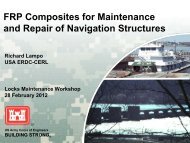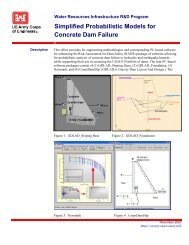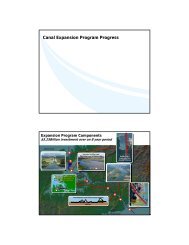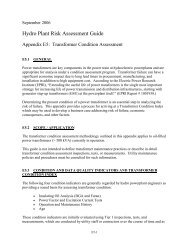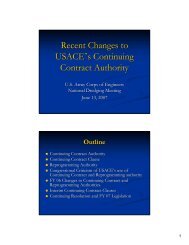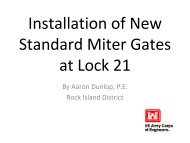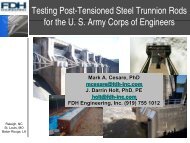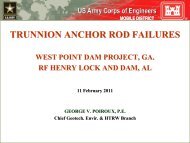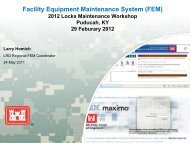Hydro Plant Risk Assessment Guide
Hydro Plant Risk Assessment Guide
Hydro Plant Risk Assessment Guide
You also want an ePaper? Increase the reach of your titles
YUMPU automatically turns print PDFs into web optimized ePapers that Google loves.
Table 2 – Gate Physical Condition<br />
Results<br />
Limited corrosion on gates, wheels, or rollers; wheels/rollers turn;<br />
coating is in good condition; anodes are in good condition; no cracked<br />
welds in structure or loose bolts/rivets; gate guides are in good<br />
condition; sill is in good condition; leakage past seals is minimal (< 25<br />
gpm or < 1.6 liters/s).<br />
Moderate corrosion on the gates, wheels, or rollers; most of the<br />
wheels/rollers turn; three-quarters of the anodes are left; no cracked<br />
welds in the structure or loose bolts/rivets; gate guides are in good<br />
condition; sill is in good condition; leakage past seals is minimal (< 25<br />
gpm or < 1.6 liters/s).<br />
Large areas of corrosion on the gates, wheels, or rollers; most of the<br />
wheels/rollers turn; one-half of the anodes are left; no cracked welds in<br />
the structure or loose bolts/rivets; gate guides are in good condition; sill<br />
is in good condition; leakage past seals is moderate (≥ 25 and < 50 gpm<br />
or ≥ 1.6 and < 3.2 liters/s).<br />
Severe corrosion on the gates, wheels, or rollers; few of the<br />
wheels/rollers turn; coating is poor; one-quarter or less of the anodes are<br />
left; some cracked welds in the structure or loose or missing bolts/rivets;<br />
gate guides are in poor condition; sill is in poor condition; excessive<br />
leakage past the seals (≥ 50 gpm or ≥ 3.2 liters/s).<br />
Gate Condition<br />
Indicator Score<br />
3<br />
2<br />
1<br />
0<br />
Valves<br />
Types of valves generally used for emergency closure purposes are: Butterfly, Spherical, and<br />
Cone (plug) valves.<br />
The known physical condition of the emergency closure valves is a major indicator of overall<br />
system reliability. For this assessment, the valve will be looked at specifically. This indicator is<br />
based on maintenance records and past inspection reports only. Items to note from records with<br />
regard to the valves are: Condition of the inside of the valve. Is cavitation present Condition<br />
of the valve seals and sealing surfaces, condition of bearings/bushings, condition of greasing<br />
system, overall structural soundness and condition, corrosion, damage to valve, condition of<br />
valve bypass.<br />
Qualified personnel should make a subjective determination of scoring that encompasses as<br />
many factors as possible under this indicator. Results are analyzed and applied to Table 3 to<br />
arrive at an appropriate Valve Condition Indicator Score.<br />
E11-6




